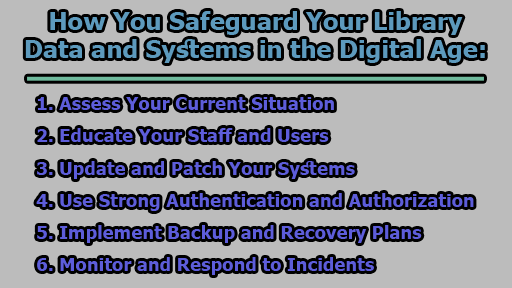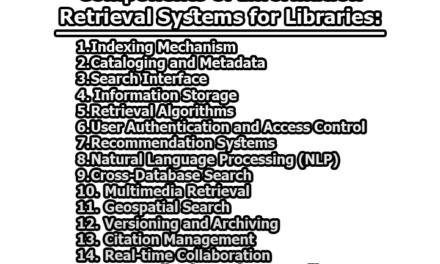How You Safeguard Your Library Data and Systems in the Digital Age:
In today’s digital age, libraries have become increasingly reliant on digital tools and platforms to provide services, manage collections, and communicate with users. While this digital transformation has revolutionized the way libraries operate, it has also exposed them to various cyber threats and risks. Data breaches, ransomware attacks, phishing attempts, and malware infections can all compromise the integrity of library data and systems. To protect your library’s digital assets and reputation, it’s crucial to implement effective security measures. In the rest of this article, we will explore how you safeguard your library data and systems in the digital age.
1. Assess Your Current Situation: Before you can effectively secure your library’s digital assets, you need to understand your current situation and identify potential vulnerabilities. Start by conducting a comprehensive security audit of your library’s data and systems, which should include hardware, software, networks, databases, websites, cloud services, and third-party vendors. Evaluate your existing security policies, procedures, and practices and look for gaps or weaknesses. You can refer to established frameworks and standards such as NIST, ISO, or COBIT to guide your assessment.
2. Educate Your Staff and Users: Human error and negligence are among the most common sources of security incidents. To mitigate this risk, it’s essential to educate your staff and users about the importance of security and how to avoid common pitfalls. Offer regular training and updates on security topics, including password management, encryption, backup best practices, phishing awareness, and social engineering. Create a security culture that encourages awareness, responsibility, and reporting. Use various communication methods, such as posters, newsletters, or quizzes, to reinforce security messages.
3. Update and Patch Your Systems: Keeping your systems updated and patched is paramount to security. Outdated or unpatched systems are more vulnerable to exploits and attacks, as hackers can take advantage of known flaws or bugs. Develop a schedule and a process for updating and patching your systems, covering operating systems, applications, browsers, plugins, and antivirus software. Utilize tools like WSUS, SCCM, or Ninite to automate and manage updates and patches.
4. Use Strong Authentication and Authorization: Authentication and authorization are vital for preventing unauthorized access to your data and systems. Implement strong authentication and authorization methods, including complex passwords, multifactor authentication, single sign-on, role-based access control, and network segmentation. Enforce password policies such as expiration, length, and complexity, and limit the use of shared or generic accounts.
5. Implement Backup and Recovery Plans: Backup and recovery plans are essential for ensuring the continuity and availability of your library services in case of data loss, corruption, or damage. Develop and implement backup and recovery plans, scheduling regular backups, storing backups in different locations or media, testing backups for integrity and usability, and documenting recovery procedures and roles. Use encryption and compression to secure and optimize your backups.
6. Monitor and Respond to Incidents: Monitoring and responding to incidents are critical for detecting and resolving security issues that could affect your data and systems. Set up alerts and notifications, log and analyze activities and events, report and escalate incidents, isolate and contain incidents, and restore and recover from incidents. Utilize tools like SIEM (Security Information and Event Management), IDS (Intrusion Detection Systems), or IPS (Intrusion Prevention Systems) to help you monitor and respond to incidents.
Remember that security measures should be balanced with usability. While it’s essential to secure your digital assets, it’s equally important to ensure that security measures do not hinder usability. Consider workflows and use case scenarios when implementing security measures and aim for practical and usable solutions.
In conclusion, securing your library’s data and systems in the digital age is a multifaceted challenge, but by following these tips and best practices, you can significantly reduce the risk of cyber threats and ensure the safety and integrity of your digital assets. Protecting your library’s reputation and the trust of your users should be a top priority, and a strong security strategy is essential in achieving this goal.

Former Student at Rajshahi University










